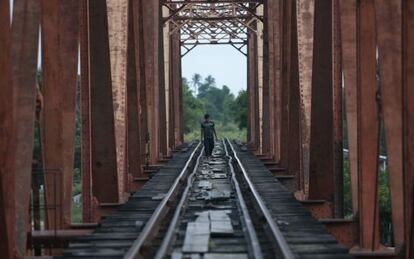Mexico tries to stem flow of Central American migrants to United States
Civic organizations say new measures make crossing even more treacherous

Mexican authorities say the country’s immigration strategy, Programa Frontera Sur, has succeeded in getting 6,000 people off the notorious “Beast” – the freight train that migrants jump aboard to travel across Mexico to the United States – but has yet to specify when or where. The government brought its new policy into force in July and has insisted that its border security plans in Central America seek to guarantee the personal safety of migrants. But some organizations say the decision has only “increased the dangers” and made undocumented travelers “more vulnerable.”
Humberto Mayans, coordinator for the government office that oversees migrant issues at the southern border, says the measures seek to “respect the dignity” of the migrants. On Tuesday, he announced the government’s plan to carry out satellite monitoring and place patrols along the train’s routes to prevent crimes.
But such methods do not and will not stop the flow of people toward the north. At least, that is what some defenders of migrants’ rights say. Rubén Figueroa from Movimiento Migrante Mesoamericano says Central Americans have started using alternative routes to avoid border police. According to Figueroa, 500 migrants used to board The Beast every day in Arriaga, in the southeastern state of Chiapas, 200 kilometers from the border with Guatemala. Now, only 15 or 20 catch the train there. About 250 people used to climb aboard in Tenosique, Tabasco, the train’s other point of departure, located 50 kilometers from the border. Now, only about 30 people get on. “They are using unknown and much more dangerous routes. Our job is to find out what they are in order to accompany them,” Figueroa says.
They rob and beat them and they walk hundreds of kilometers because they believe that there is still an opportunity in the United States”
A worker at a migrant shelter in Mexico
“They will never stop them. Now they walk on the train tracks, which is much more dangerous,” says Germán Guillermo Ramírez Mendoza, president of Santa Faustina, a migrant shelter in Coatzacoalcos, Veracruz. “They keep coming as usual. Before, they would travel in groups of 200, 500, or even 800 and they could protect themselves better. The smaller the groups, the more dangers they face.”
Coatzacoalcos, 320 kilometers from Arriaga and 370 kilometers west of Tenosique, is one of a number of “rest stops” on the long journey Central American migrants make to reach the United States. During the trip, they are vulnerable to robbery, abuse, extortion, rape and murder. Santa Faustina has the capacity to house 100 people and, on average, they stay one month before continuing their journey.
The Mexican government has said the most important objective is to prevent migrants from riding aboard The Beast and facing the dangers that trip involves. One of the measures used to achieve that goal has been to increase the train’s speed. Hundreds of people have since died or been mutilated while trying to climb aboard or being thrown off the train.
Authorities announced the new measures a little after Washington sounded the alarm. At least 57,000 minors were detained at the Mexico-United States border between October 2013 and June 2014. President Barack Obama has broken the record for deportations, expelling almost two million people during his time in office. And he has blamed his Republican opponents for blocking immigration reform, the great matter pending before his administration.
The Association of Deported Migrants with Disabilities created by Central American travelers who got injured en route to the United States organized a demonstration in Mexico in April to demand reparations for abuses committed by President Enrique Peña Nieto’s government on Mexican soil. The group calls for the creation of a one-month “humanitarian visa” that would allow migrants to travel legally through Mexico. The Latin American country currently requires a tourist visa for visitors from Guatemala, El Salvador, Honduras and Nicaragua.
The Mexican government allows individuals from Guatemala and Belize to remain in the country for three days on a “regional visitor’s pass” valid for five years. According to Mayans, authorities granted 10,000 passes in August.
The journey across Mexico covers three different routes: the trail along the Gulf of Mexico on the east coast that passes through Veracruz en route to Reynosa and Matamoros; the central route that covers Zacatecas, San Luis Potosí, Coahuila and Nuevo León, among other states, and arrives at Nuevo Laredo and Ciudad Juárez; and the Pacific track on the west coast, the longest of the routes, with a “rest stop” in Guadalajara and leading to Tijuana, not far away from San Diego, California.
This journey is thousands of kilometers long but children, women and men cover it every day in the hope of getting a small bite of the American Dream. “They rob and beat them and they walk hundreds of kilometers because they believe that there, in the United States, they could do something, that there is still an opportunity, that it is still the country it was 10 years ago,” Ramírez says. “Some travel on foot, others by bus. They get off one and run to get on another so they won’t be seen. They climb hills. And they play that game with the immigration authorities of ‘I send you back and you come again.’ There are guys here who have crossed over five or 10 times. And all this just to put bread on the table.”
Translation: Dyane Jean François
Tu suscripción se está usando en otro dispositivo
¿Quieres añadir otro usuario a tu suscripción?
Si continúas leyendo en este dispositivo, no se podrá leer en el otro.
FlechaTu suscripción se está usando en otro dispositivo y solo puedes acceder a EL PAÍS desde un dispositivo a la vez.
Si quieres compartir tu cuenta, cambia tu suscripción a la modalidad Premium, así podrás añadir otro usuario. Cada uno accederá con su propia cuenta de email, lo que os permitirá personalizar vuestra experiencia en EL PAÍS.
En el caso de no saber quién está usando tu cuenta, te recomendamos cambiar tu contraseña aquí.
Si decides continuar compartiendo tu cuenta, este mensaje se mostrará en tu dispositivo y en el de la otra persona que está usando tu cuenta de forma indefinida, afectando a tu experiencia de lectura. Puedes consultar aquí los términos y condiciones de la suscripción digital.









































